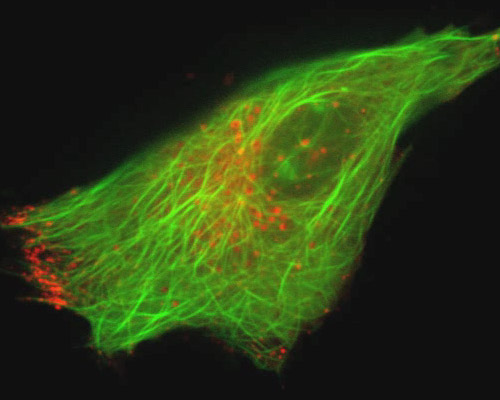Grey Fox Lung Cells with mEmerald-MAP4 and mCherry-Rab5a

The grey fox is monogamous, and the breeding season differs depending on geographic location. In Alabama, for example, the highest point of breeding occurs in February. The gestation period lasts around 50 days. 1 to 7 kits are born in each litter. They begin hunting at the age of 3 months with their parents, but by a month later, the kits are able to forage by themselves. The family stays together until fall when the young reach sexual maturity and separate.
Rab5a and other Rabs are Ras related proteins associated with the trafficking of vesicles and cell signaling. First discovered in the 1980s, Rab proteins have found use among microscopists as markers of endosomes. About 70 Rab proteins have been identified so far in human cells, and certain Rabs localize only to endosomes in particular stages. Rab5a is specifically a marker of early endosomes. These endosomes are newly formed and only mildly acidic, so that minimal degradation occurs. Degradation increases significantly as early endosomes become increasingly acidic and evolve into late endosomes.
Early endosomes present in cultured fox lung cells were fluorescently tagged with mCherry fused to Rab5a. The red fluorescent protein mCherry was developed through directed mutagenesis of mRFP1, a monomeric DsRed mutant. The FoLu cells were also labeled for microtubules with mEmerald fused to MAP4, a microtubule-associated protein. mEmerald is a green variant of Aequorea-based EGFP.



